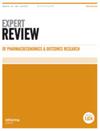丙型肝炎直接作用药物的成本效益。
IF 1.8
4区 医学
Q3 HEALTH CARE SCIENCES & SERVICES
Expert Review of Pharmacoeconomics & Outcomes Research
Pub Date : 2024-04-26
DOI:10.1080/14737167.2024.2348053
引用次数: 0
摘要
导言直接作用抗病毒药物(DAA)的问世改变了慢性丙型肝炎(HCV)的治疗,并使世界卫生组织提出的到 2030 年根除 HCV 的目标成为可能。成功根除 HCV 需要克服多重障碍。本综述将评估DAA治疗慢性HCV患者的成本效益,重点关注普通人群、肝硬化患者和易感人群。专家观点目前存在多种障碍,限制了HCV的根除,包括治疗成本、可及性、简化检测以及实施促进所有HCV患者群体治疗的政策。在临床上,DAAs 已极大地改变了 HCV 的治疗格局,但仍需重点关注弱势群体。公共政策将继续在消除 HCV 方面发挥重要作用。虽然我们将重点关注 DAA 的成本效益,但有关 HCV 的其他一些因素也需要持续关注,如提高公众意识和减少与 HCV 相关的社会耻辱感、提供普遍筛查和治疗链接,以及改进预防干预措施以减少 HCV 的传播。本文章由计算机程序翻译,如有差异,请以英文原文为准。
Cost effectiveness of hepatitis C direct acting agents.
INTRODUCTION
Introduction of direct acting antivirals (DAA) has transformed treatment of chronic hepatitis C (HCV) and made elimination of HCV an achievable goal set forward by World Health Organization by 2030. Multiple barriers need to be overcome for successful eradication of HCV. Availability of pan-genotypic HCV regimens has decreased the need for genotype testing, but maintained high efficacy associated with DAAs.
AREAS COVERED
In this review, we will assess the cost-effectiveness of DAA treatment in patients with chronic HCV disease, with emphasis on general, cirrhosis, and vulnerable populations.
EXPERT OPINION
Multiple barriers exist limiting eradication of HCV, including cost to treatment, access, simplified testing, and implementing policy to foster treatment for all groups of HCV patients. Clinically, DAAs have drastically changed the landscape of HCV, but focused targeting of vulnerable groups is needed. Public policy will continue to play a strong role in eliminating HCV. While we will focus on the cost-effectiveness of DAA, several other factors regarding HCV require on going attention, such as increasing public awareness and decreasing social stigma associated with HCV, offering universal screening followed by linkage to treatment and improving preventive interventions to decrease spread of HCV.
求助全文
通过发布文献求助,成功后即可免费获取论文全文。
去求助
来源期刊

Expert Review of Pharmacoeconomics & Outcomes Research
HEALTH CARE SCIENCES & SERVICES-PHARMACOLOGY & PHARMACY
CiteScore
4.00
自引率
4.30%
发文量
68
审稿时长
6-12 weeks
期刊介绍:
Expert Review of Pharmacoeconomics & Outcomes Research (ISSN 1473-7167) provides expert reviews on cost-benefit and pharmacoeconomic issues relating to the clinical use of drugs and therapeutic approaches. Coverage includes pharmacoeconomics and quality-of-life research, therapeutic outcomes, evidence-based medicine and cost-benefit research. All articles are subject to rigorous peer-review.
The journal adopts the unique Expert Review article format, offering a complete overview of current thinking in a key technology area, research or clinical practice, augmented by the following sections:
Expert Opinion – a personal view of the data presented in the article, a discussion on the developments that are likely to be important in the future, and the avenues of research likely to become exciting as further studies yield more detailed results
Article Highlights – an executive summary of the author’s most critical points.
 求助内容:
求助内容: 应助结果提醒方式:
应助结果提醒方式:


